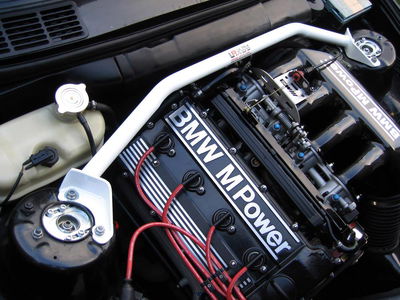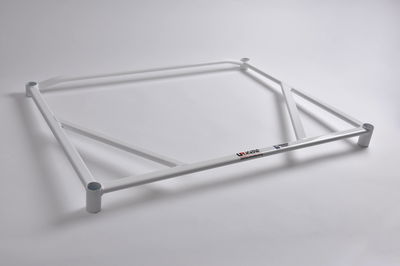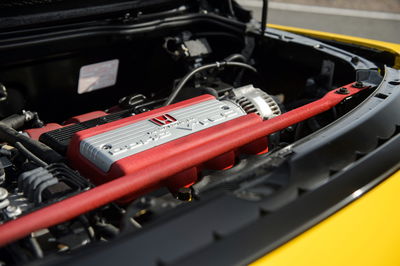How Does Chassis Bracing Work, And Is There Any Point?

You’ve probably all seen those shiny bars sitting across the engine bays of modified cars and even some stock performance machines. They usually look great (particularly the posh carbonfibre parts some main manufacturers fit), and you no doubt know they should make the car better to drive. But have you ever stopped to contemplate the science behind these parts?
Consider a MacPherson strut suspension setup (and if you have no idea what that is, have a skim of our handy guide). Here, we have a single control arm with a damper running from it to the body. During cornering, a rotating force will be exerted on the control arm, which is transferred up the strut to its mounting point, effectively pulling the body of the car down. This is known as chassis flex.

It’s nothing your car can’t handle, but it’s seen as undesirable, making the car less reactive to your inputs than a keener driver would ideally like. By joining the suspension struts at the top mounts with a nice, solid bar, the force is evenly distributed across both towers, counteracting the flex. After fitting, a car should turn in that little bit sharper, as there won’t be the delay in the car reacting caused by the flex. Lovely.
What you do have to bear in mind though, is a strut bar will be much more effective with a MacPherson strut suspension arrangement. On a double wishbone setup, the force exerted on the bottom control arm is cancelled out by the movement of the upper arm. There are still vertical forces being exerted on the body as the dampers are exerted, so it can be worth sharing that load across each side with a strut bar.
There’s still a potential benefit, just a smaller one, which is why plenty of double wishbone-suspended cars are fitted with braces from the factory.

Strut braces are probably the most well-known kind of bracing methods, but there many options for those looking to stiffen their car and improve the way it behaves. Bars for the bottom mounts as well as the top exist, or if you want to go one step further, more extensive chassis braces (pictured below) that attach to multiple points on the underside of your car are available, which help counter general chassis flex.
A more niche form of bracing is the fender bar. These triangular bars are bolted on under the front wings, with the aim of counteracting the twisting force exerted on the point where the A-pillar and the front of the chassis meet.

The most extreme solution? That’d be welding in a full roll cage. The primary reason for fitting a cage to a car is safety, but this has the welcome side effect of increasing stiffness. It’s not hard to see why - the principle is the same as under-body chassis braces, only here, many more points of the chassis are linked up to one extremely rigid structure.
Away from the world of motorsport and the most extreme track cars, you’re unlikely to want to go down this route. But how about the other forms of bracing we’ve discussed? Is there any point?

There’s no easy answer to that - it all depends on what car the bracing is being fitted to, the parts it already has and what else is planned for it. A strut brace is not going to have as noticeable an effect on the way your car drives as something like a new set of coilovers, and there won’t be much point in adding one to a car whose suspension components are saggy and worn out.
Like many components, strut and chassis braces are best thought of as one component of a wider build - a series of smaller upgrades that add up to significant improvement.
Have you fitted any chassis bracing parts to your car? What did you go for, and why? Let us know in the comments.














Comments
And people complain that the CT staff makes bad posts…. This is great!
Now just waiting for EngineeringExplained to make a follow-up!
Making sense of the science!
it brightens my day that the quality posts are coming. This one is actually very interesting!!!!!
They can really strut their stuff now can’t they?
Another niche solution would be structural adhesive. These glues provide a surprising amount of support, and some chassis are made out of glued aluminum because the gluing spreads pressure more evenly than bolting or welding. This is a great alternative to cluttering up your interior with bars. Street racers in Asia do this because some cages are illegal to install on a street car.
*seam welding
Yeah, who needs roll cages, just use FLEX GLUE™ instead
Is that last Honda a DC2?
No I think it’s an nsx
100% it works. I went from bad oversteer to very manageable neutral feel
I’d only fit one because they look sick. Can’t be called rice because it minutely aids performance
I really really like this article. pls make more of these!!!
It’s too application specific to say “yes they work” or “no they don’t” simply because it’s 100% dependant on the design/location of the brace and the car itself. If it cures a real weak area of a chassis it can have a huge effect.
I fitted a front lower brace to my car and it made the front end feel much more solid especially over broken roads. The area it braced was an obvious weak point of the chassis however and the same/similar brace on another car wouldn’t necessarily have as big an effect.
Also think that fitting stiff coilovers to car with a wobbly chassis is as bad as having worn out suspension.
bracing works, as if drop the rear seats in my car, it gets all floppy, and unnerving, throw them back up and it’s a lot more predictable, and stable.
Had a front lower brace fitted to my FWD car. The car felt taught in corners but the stiffness made the car very harsh over bumps. On track days the car with the brace had worse times than without, a result (in my opinion) of the stiffness which caused the tires to “give up earlier”.
Despite this i believe they do work, provided they have been engineered for the car properly and server the weak points. But there are some trade-offs especially on normal everyday cars
They’re to help save lives from when the engine explodes because a teenager got behind the wheel
Pagination